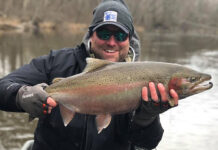As nocturnal creatures, most mammals hide under the cloak of darkness. Squirrels are one exception to that rule. Even young children recognize gray squirrels, fox squirrels, and chipmunks that frequent backyards and city parks during daylight hours.
And of all North American squirrels, only one large diurnal ground squirrel is celebrated by both its own holiday and motion picture. Everybody knows Groundhog Day.
Punxsutawney Phil
Each year on Feb. 2, Groundhog Day, handlers at Gobbler’s Knob, Pennsylvania, remove Punxsutawney Phil from his den. It’s an event that makes local and even national television news.
If Phil sees his shadow, we’ll have six more weeks of winter. No shadow, and we get an early spring. At least that’s the myth, the legend, the old wives’ tale.
Of course, it’s all hogwash. Rousing a sleeping groundhog from hibernation to see its shadow Feb. 2 is no better a predictor of winter weather than checking woolly bear color bands in the fall.
But it’s all harmless fun. Just ask the folks in Punxsutawney. Groundhog Day is a huge event there; thousands of visitors attend, and corporate sponsors even help make it happen. It’s the one day of the year when just about everyone pays attention to groundhogs, if only for a few hours.
Eastern states
And Pennsylvania isn’t the only place that really celebrates Groundhog Day. More than a few other states have come up with ways to honor (and cash in on) groundhogs. In Ohio, for example, Buckeye Chuck assumes Phil’s role. In Michigan, it’s Woodchuck Woody. Staten Island Chuck takes center stage in New York. And in West Virginia, it’s French Creek Freddie, named for his home at the State Wildlife Center. Maine has W. Chuck Berry. Dunkirk Dave presides over western New York. In Raleigh, North Carolina, Sir Walter Raleigh makes the forecast. And the Tennessee Aquarium is home to Chattanooga Chuck.
Western alternatives
Because groundhogs occur only in the eastern U.S., some western states have come up with creative ways to be part of the holiday. Sarah Palin signed legislation that designated Feb. 2 as “Marmot Day” when she was governor of Alaska. Several additional species of marmots live in western states. Colorado, for example, relies on the wisdom of Flatiron Freddie, a yellow-bellied marmot.
The silliness of all this is that groundhogs at midlatitudes rarely venture from their burrows Feb. 2. They are still sound asleep deep in their burrows. After they enter their winter dens in the fall, groundhogs plug the entrance to the burrow and curl into a snuggly ball. Their body temperature drops about 57 degrees to 40 degrees, and their pulse drops from more than 100 beats per minute to just four beats per minute. Clearly few wild groundhogs see the light of day Feb. 2.
European origins
So how did the tradition of Groundhog Day begin? It actually started centuries ago with a European church holiday, Candlemas.
A verse from an old English song set the stage:
If Candlemas be fair and bright; Come Winter, have another flight;
If Candlemas brings clouds and rain; Go Winter, and come not again.
In that short verse and others like it from Europe, lay the roots of Groundhog Day. Candlemas dates back to early Christianity in Europe, celebrating Christ as the “light of the world.”
On Feb. 2, the clergy blessed and distributed candles for the people to display in their windows. Early Europeans watched to see if hedgehogs saw their shadows to predict the remainder of winter.
In the absence of hedgehogs in North America, early Americans decided groundhogs would make a reasonable substitute. German settlers brought with them the tradition of Candlemas. The belief was that at the midpoint between the winter solstice and spring equinox, if the weather was fair, the second half of winter would be cold and cruel. If the skies were cloudy, an early spring would follow.
The first record in 1842 of groundhogs being used to predict winter weather can be traced to Pennsylvania Dutch culture in Berks County, Pennsylvania.













